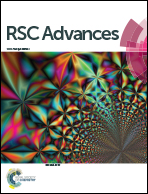Synthesis of narrow-band curled carbon nitride nanosheets with high specific surface area for hydrogen evolution from water splitting by low-temperature aqueous copolymerization to form copolymers†
Abstract
Carbon nitride has become a focus of photocatalytic materials research in recent years, but the low specific surface area, the bad separation efficiency of photocarriers, poor quantum efficiency, terrible photocatalytic activity hinder the development of carbon nitride in the field of photocatalysis. The preparation of carbon nitride nanosheets is one of the effective methods to improve the photocatalytic efficiency of carbon nitride, but the traditional top-down stripping process is time-consuming, complicated and expensive. Here we report a simple, cheap, non-toxic and environmentally friendly bottom-up method to prepare a curled g-C3N4 nanosheet (NS-C3N4), which is performed at low temperature and normal pressure. In the aqueous solution, melamine and cyanuric acid are copolymerized to form a copolymer. Glycerol is inserted between the molecular layers of the prepolymer by thermal diffusion. Finally, high-quality and high-yield curled g-C3N4 nanosheets (NS-C3N4) are obtained by thermal peeling and polycondensation. The NS-C3N4 has an highly efficient photocatalytic hydrogen production of 4061.8 μmol h−1 g−1, and the hydrogen evolution activity is 37.5 times that of bulk-C3N4 (B-C3N4). The specific surface area of NS-C3N4 is 60.962 m2 g−1. UV-vis absorption spectra, steady-state and time-resolved photoluminescence, and photoelectrochemical tests were used to study its photocatalytic mechanism.



 Please wait while we load your content...
Please wait while we load your content...